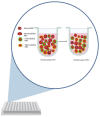Babesia divergens Shows Equal Predilection for Human ABO Blood Types in an In Vitro Erythrocyte Preference Assay
- PMID: 37375493
- PMCID: PMC10304887
- DOI: 10.3390/pathogens12060803
Babesia divergens Shows Equal Predilection for Human ABO Blood Types in an In Vitro Erythrocyte Preference Assay
Abstract
Babesia is spread to humans via ticks or blood transfusions. Severity of Plasmodium falciparum malaria is strongly correlated to the ABO blood group of the patient. Babesia divergens is an intraerythrocytic parasite with many similarities to malaria, but the impact of ABO on the susceptibility to and progression of the infection in humans is unknown. We have now cultured B. divergens in human group A, B and O erythrocytes in vitro and measured rates of multiplication. The predilection for the different erythrocyte types was also determined using an in vitro erythrocyte preference assay when the parasites were grown in group A, B or O erythrocytes over time and then offered to invade differently stained erythrocytes of all the blood types at the same time. The results showed no difference in multiplication rates for the different blood types, and the parasite exhibited no obvious morphological differences in the different blood types. When cultured first in one blood type and then offered to grow in the others, the preference assay showed that there was no difference between the A, B or O blood groups. In conclusion, this indicates that individuals of the different ABO blood types are likely to be equally susceptible to B. divergens infections.
Keywords: ABO; Babesia divergens; blood type; preference assay.
Conflict of interest statement
The authors declare no conflict of interest.
Figures





Similar articles
-
Four-Dimensional Characterization of the Babesia divergens Asexual Life Cycle, from the Trophozoite to the Multiparasite Stage.mSphere. 2020 Oct 14;5(5):e00928-20. doi: 10.1128/mSphere.00928-20. mSphere. 2020. PMID: 33055261 Free PMC article.
-
Individual heterogeneity in erythrocyte susceptibility to Babesia divergens is a critical factor for the outcome of experimental spleen-intact sheep infections.Vet Res. 2009 Jul-Aug;40(4):25. doi: 10.1051/vetres/2009008. Epub 2009 Feb 27. Vet Res. 2009. PMID: 19245784 Free PMC article.
-
[Laboratory diagnostic of human babesiosis.].Klin Lab Diagn. 2019;64(9):560-564. doi: 10.18821/0869-2084-2019-64-9-560-564. Klin Lab Diagn. 2019. PMID: 31610109 Russian.
-
A historical review of Babesia spp. associated with deer in Europe: Babesia divergens/Babesia divergens-like, Babesia capreoli, Babesia venatorum, Babesia cf. odocoilei.Vet Parasitol. 2021 Jun;294:109433. doi: 10.1016/j.vetpar.2021.109433. Epub 2021 Apr 22. Vet Parasitol. 2021. PMID: 33930692 Review.
-
Babesia divergens: A Drive to Survive.Pathogens. 2019 Jul 2;8(3):95. doi: 10.3390/pathogens8030095. Pathogens. 2019. PMID: 31269710 Free PMC article. Review.
Cited by
-
How to Detect Antibodies Against Babesia divergens in Human Blood Samples.Open Forum Infect Dis. 2024 Jan 16;11(2):ofae028. doi: 10.1093/ofid/ofae028. eCollection 2024 Feb. Open Forum Infect Dis. 2024. PMID: 38328497 Free PMC article.
References
-
- Burgess M.J., Rosenbaum E.R., Pritt B.S., Haselow D.T., Ferren K.M., Alzghoul B.N., Rico J.C., Sloan L.M., Ramanan P., Purushothaman R., et al. Possible Transfusion-Transmitted Babesia divergens-like/MO-1 Infection in an Arkansas Patient. Clin. Infect. Dis. 2017;64:1622–1625. doi: 10.1093/cid/cix216. - DOI - PubMed
Grants and funding
LinkOut - more resources
Full Text Sources

